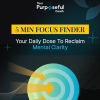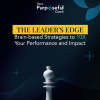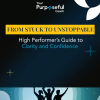
Most of us claim to crave stillness. But when was the last time you sat with it, uninterrupted?
As someone who thrives on conversation, energy, and spirited exchanges, the idea of complete silence felt, quite frankly, intimidating. My professional and social life revolve around communication, and those close to me have on occasion called me the most talkative person in the room. So, when I committed to a three-day guided silence retreat with the Art of Living Foundation, I underestimated just how challenging “no talking” would truly feel.
Here’s what the experience taught me about clarity, presence, and the power of truly listening—to both myself and the world around me.
The Modern Mind Isn’t Wired for Silence
I work with high-achieving professionals who are constantly on. Many are experts at navigating external noise but struggle with their own inner chatter.
Going silent can sound deceptively simple. In reality, all the busyness we carry rises up quickly when distractions are paused.
Extroverts like me often process thoughts aloud, using words to make sense of the world. Yet, neuroscience research shows that when we radically reduce verbal engagement, our brain’s default mode network (DMN) – ramps up activity, fostering internal observation and reflection. These brain circuits, active during wakeful rest and introspection, help consolidate memories and provide rich soil for creative insights and self-understanding. This switch from external dialogue to internal observation is where much of the personal transformation begins.
A Day in the Silence Retreat
For the first few hours, the stillness was almost physical. My habits pulled me toward my phone, email, even self-coaching prompts—anything but settling into this raw, unfiltered mental space.
As the first day continued, something shifted: the restlessness softened. Beneath the noise, a different kind of clarity started to emerge.
A glimpse into the retreat rhythm:
- Early morning: Gentle yoga to awaken the body and mind, followed by guided meditation to set a contemplative tone.
- Throughout the day: Structured breathwork exercises (like Sudarshan Kriya) and powerful pranayama to calm the nervous system and deepen awareness—which research shows can reduce stress, anxiety, and symptoms linked to trauma.
- Afternoons: Deeper meditations (including yoga nidra), ancient chants, and gentle movement, for a balance of activity and rest.
- Between sessions: Nature walks after breakfast and in the evening; meals in mindful silence, savoring each bite; introspective journaling.
- Evenings: Closing with reflection, music, and gratitude, celebrating the day and preparing for another inward-facing day.
The design of the program weaves movement, stillness, and deep breathing—encouraging a whole-body reset.
Explore more about the retreat here
The Jarring Beauty of the Pause
When words fell away, I realized my other senses grew louder and felt newly alert:
- Sunlight and rain: I noticed how the sun moved through the day, shifting the quality of light, interspersed with Bangalore rain.
- Nature walks: The crunch of gravel and the interplay of birdsong became richer and deeply grounding.
- Body awareness: Every muscle and stretch in each yoga asana felt different.
- Taste: Even ordinary meals tasted new, as though my sense of taste came fully online for the first time in months.
Each sense, no longer dulled by constant speech, became a pathway into presence.
According to neuroscience, reducing verbal processing can heighten our awareness of sensory input, causing our attention to recalibrate to the present. Small experiences—texture, temperature, rhythm—become surprisingly anchoring.
From Discomfort to Deep Calm
Sometimes, “reflection” feels like one more thing on your to-do list. But by the second day, the initial urge to speak started to fade. My mind, once bustling, felt stiller. Emotions and thoughts surfaced—sometimes uncomfortably—only to dissolve with each meditation and breath.
- Long walks outside became moving meditations.
- Insights surfaced not because I chased them, but because I was still enough to let them land.
- Old stressors, once tangled in overthinking, began to loosen their grip.
By the end of Day 3, I almost wished for more time in the quiet. What started as daunting had become a sanctuary. Inspired by this shift, I’m even considering a longer, six-day silence retreat next year (baby steps!).
After the Silence: What Changed
Three days of intentional silence stripped away any illusion of multitasking. With nowhere to run from uncomfortable thoughts, I found room for deeper emotional clarity.
- Renewed clarity and inner peace: The retreat offered a mental reset, clearing away habitual noise and allowing my intuition to surface.
- A deep, steady peace: An equilibrium that lingered beyond the structured program, anchoring me as I returned to daily routines.
- Improved emotional resilience: I learned to sit with discomfort and let it pass, rather than escape into distraction.
- A felt sense of reset for body and mind: The combination of silence, movement, and breathwork allowed me to be less reactive, more centered, and navigate stress with greater ease.
Was it easy? Not always.
Was it worth it? Absolutely.
For anyone—especially my fellow extroverts—craving true calm, deeper self-understanding, and practical mindfulness tools, I highly recommend the silence retreat.
What Stayed With Me (and Might Support You, Too)
Here’s what I’m carrying forward, personally and professionally:
- Silence isn’t about muting your life. It’s about creating space for what needs to be heard.
- Your intuition gets clearer when you’re willing to listen without editing or striving.
- Nature, movement, and simple presence can be the most powerful reset for a busy mind.
- You don’t need three days of silence to pause. But you might need a real moment—no phone, no agenda, just space to notice.
For high-achievers who crave clarity and calm, this might feel uncomfortable at first. With practice, it’s a powerful tool for self-awareness, resilience, and renewal.
💬 Share your own experience for finding presence amidst the noise—would love to hear!
–
Anshuma Arora Mukkamala, ACC
Leadership and Mindset Coach transforming high-performers into confident leaders




